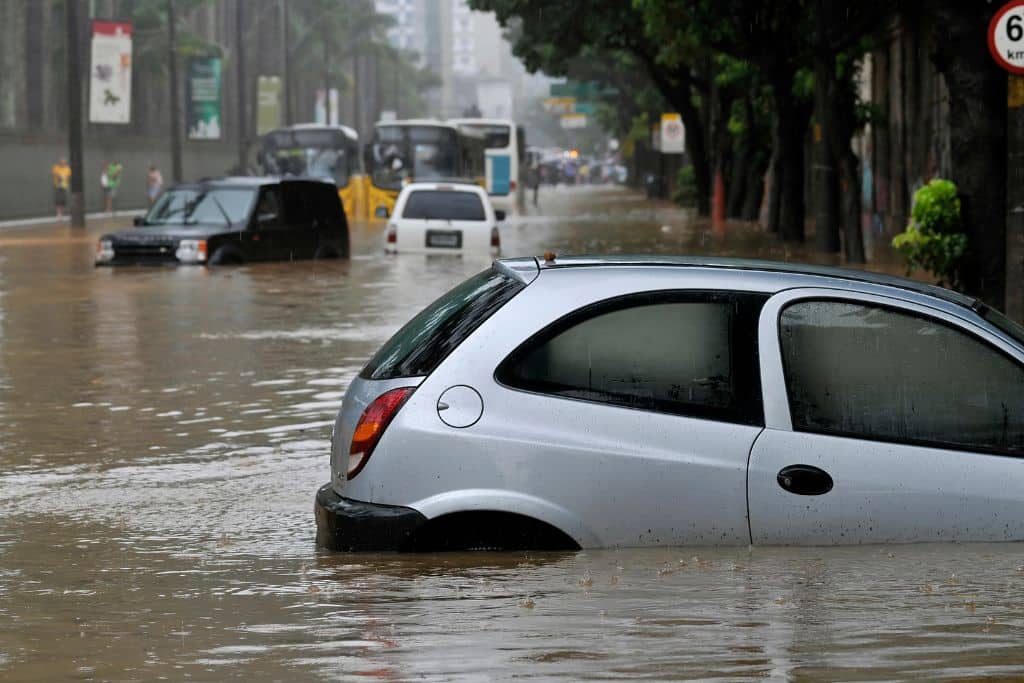The heavy rain has brought parts of the United Arab Emirates (UAE) and Oman to a standstill, flooding highways, inundating houses and businesses, and trapping people in their homes.
—
At least 20 people have died in Oman and one in the United Arab Emirates following a powerful storm that brought torrential rain, the heaviest in at least 75 years, to the drought-stricken region.
The storm initially hit Oman on Sunday before moving to the UAE on Tuesday, knocking out power lines, flooding roads and houses, and disrupting air traffic.
Al Ain, a city bordering Oman, was hit by a record 254 millimeters (around 10 inches) of rainfall in just 24 hours, the largest amount since records began in 1949. Videos circulating on social media show collapsed roads and streets turned into rivers, with cars being swept away.
The heavy downpour also brought Dubai, the largest city in the UAE and a popular tourist destination, to a standstill, with road and air traffic halted and schools closed. The city of 3.3 million received 100 millimeters (around 4 inches) of rain in just 12 hours, around the same amount it typically sees in an entire year.
On Wednesday, Dubai International Airport, the busiest airport in the world, reported “operational challenges” and advised passengers not to travel, adding they were “working hard to recover operations as quickly as possible in very challenging conditions.” Inbound flights resumed on Thursday, though the airport authority warned passengers of continued delays and disruptions.
What Caused it?
Experts are divided on what’s behind the historic downpour.
Both Oman and the United Arab Emirates are among the world’s most water-stressed countries, with the World Resources Institute ranking its baseline water stress as extremely high risk across the agricultural, domestic, and industrial sectors.
In a bid to fight the severe drought conditions, both countries rely on a weather modification method known as cloud seeding. At its essence, cloud seeding ambitiously attempts to assist Mother Nature by introducing into the clouds additional “nuclei” around which water condenses, stimulating precipitation. This can be done using ground-based generators, rockets, and aircraft. The cloud seeding industry has always been a topic of debate. Advocates highlight its efficacy, with studies indicating a 10-15% increase in rainfall. Conversely, skeptics raise cautionary flags, emphasizing potential hazards to public safety and the environment. Decades of research have yielded static and dynamic seeding techniques, showing indications of effectiveness by the late 1990s.
More on the topic: Unleashing the Power of Cloud Seeding: Navigating Potentials and Pitfalls
As governments and private companies weigh benefits against risks, cloud seeding remains a polarizing subject. While some countries – like the UAE – embrace it for agricultural purposes and to battle extreme heat, others proceed cautiously, aware of the potential consequences.
Early media reports on Tuesday suggested this week’s downpour may have been worsened by cloud seeding. However, in a statement to multiple outlets, the National Center of Meteorology (NCM), which oversees cloud-seeding missions in the country, said that no seeding operation had been conducted before or during the storm.
“We did not engage in any seeding operations during this particular weather event. The essence of cloud seeding lies in targeting clouds at an earlier stage, prior to precipitation. Engaging in seeding activities during a severe thunderstorm scenario would prove futile,” said NCM deputy director general Omar Al Yazeedi.
Meanwhile, other experts have also debunked the theory, saying it was misleading to attribute heavy rain to cloud seeding and instead blaming warmer weather, which can hold more moisture in the atmosphere, leading to sometimes severe downpours.
“Cloud seeding can’t create clouds from nothing. It encourages water that is already in the sky to condense faster and drop water in certain places. So first, you need moisture. Without it, there’d be no clouds,” Friederike Otto, a senior lecturer in climate science at Imperial College London, told Reuters.
2023 was the hottest year on record, supercharged by the return of El Niño, a weather phenomenon that has pushed temperatures off the charts around the world and that is expected to last well into 2024. As expected, the trend continued in the first few months of the new year, with March 2024 becoming the 10th consecutive month to break records, with temperatures at 1.77C above an estimate of the February average for 1850-1900.
From the Mediterranean to California, global warming is making heavy precipitation and flooding more likely to occur. For countries that are already prone to rainy seasons, particularly in Asia, climate models predict climate change will lead to more intense flooding and prolong existing monsoon seasons, disrupting agricultural and crop production and increasing extreme precipitation over the region as more greenhouse gasses are released into the atmosphere.
Last September, Hong Kong recorded 158.1 mm of rain, the highest hourly rainfall since records began in 1884. It came after local scientists warned that climate change would bring more frequent and intense extreme weather events to the city, including supercharged typhoons and prolonged drought as the climate crisis intensifies.
This story is funded by readers like you
Our non-profit newsroom provides climate coverage free of charge and advertising. Your one-off or monthly donations play a crucial role in supporting our operations, expanding our reach, and maintaining our editorial independence.
About EO | Mission Statement | Impact & Reach | Write for us


















